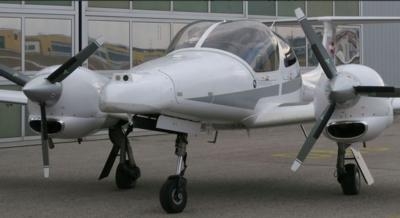Thu, Nov 17, 2016
System Should Improve Safety For Both Manned And Unmanned Flights
In close cooperation, experts of the AIT Austrian Institute of Technology and Diamond Aircraft Industries GmbH, have developed an intelligent sensor system enabling aircraft to detect and avoid potential obstacles both in the air and on the ground. This innovative airborne assistance system is an important step towards improving the safety of manned and unmanned flight.

Collision avoidance systems are a key technology for future unmanned aerial systems and advanced air traffic services. The objective is to increase the safety of manned and future unmanned aviation by detecting possible collisions with both cooperative and non-cooperative obstacles, and performing avoidance maneuvers as a last resort to avoid collisions. Obstacle avoidance is the key technology in missions involving the highest possible degree of autonomy, e.g. for generating situation maps for crisis and disaster management.
Experts at AIT have taken an innovative vision-based approach, enabling future unmanned aerial systems to observe and understand their environment in real-time. This approach goes beyond the state-of-the-art, making use of novel sensing techniques and route planning strategies for collision avoidance. The technology is capable of detecting both cooperative and non-cooperative objects in the airspace by fusing passive electro-optical and thermal-infrared sensor data. The technology was integrated in a Diamond Aircraft DA42 MPP and demonstrated in relevant scenarios.

Diamond Aircraft has used the test results to assess potential applications for this technology as an innovative and effective safety-improving feature both for unmanned flying objects and manned aviation. One option would be to integrate the technology into an autonomous flight control system similar to the one developed during a recent Diamond Aircraft project which, in 2015, successfully demonstrated safe autonomous flying for manned aircraft in emergency situations, including completely automated landing. Another possible use could be sensorial integration into conventional manned aircraft, to increase situational awareness and prevent collisions with airborne or ground obstacles. This would offer an additional and more reliable pair of artificial “eyes” able to generate potentially life-saving collision avoidance advisories.
(Images provided with Diamond Aircraft news release)
More News
Aero Linx: International Federation of Airworthiness (IFA) We aim to be the most internationally respected independent authority on the subject of Airworthiness. IFA uniquely combi>[...]
Ultrahigh Frequency (UHF) The frequency band between 300 and 3,000 MHz. The bank of radio frequencies used for military air/ground voice communications. In some instances this may >[...]
A Few Questions AND Answers To Help You Get MORE Out of ANN! 1) I forgot my password. How do I find it? 1) Easy... click here and give us your e-mail address--we'll send it to you >[...]
From 2019 (YouTube Edition): Learning To Paint Without Getting Any On Your Hands PPG's Aerospace Coatings Academy is a tool designed to teach everything one needs to know about all>[...]
Also: Sustainable Aircraft Test Put Aside, More Falcon 9 Ops, Wyoming ANG Rescue, Oreo Cookie Into Orbit Joby Aviation has reason to celebrate, recently completing its first full t>[...]
 ANN's Daily Aero-Linx (05.06.25)
ANN's Daily Aero-Linx (05.06.25) ANN's Daily Aero-Term (05.06.25): Ultrahigh Frequency (UHF)
ANN's Daily Aero-Term (05.06.25): Ultrahigh Frequency (UHF) ANN FAQ: Q&A 101
ANN FAQ: Q&A 101 Classic Aero-TV: Virtual Reality Painting--PPG Leverages Technology for Training
Classic Aero-TV: Virtual Reality Painting--PPG Leverages Technology for Training Airborne 05.02.25: Joby Crewed Milestone, Diamond Club, Canadian Pilot Insurance
Airborne 05.02.25: Joby Crewed Milestone, Diamond Club, Canadian Pilot Insurance




